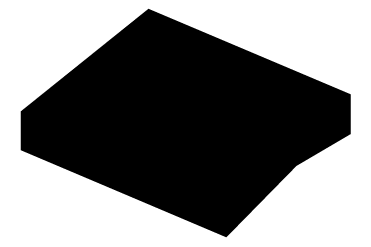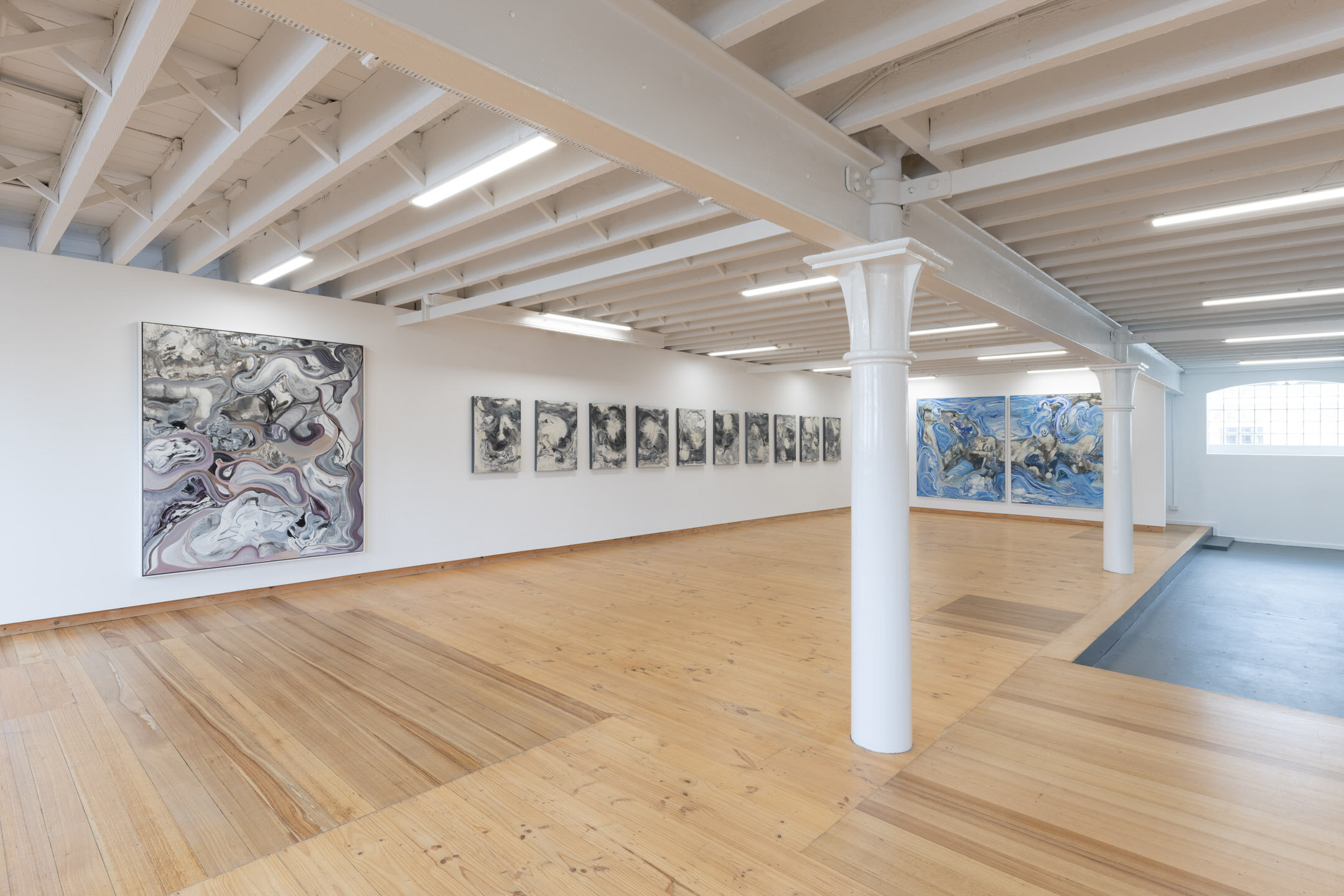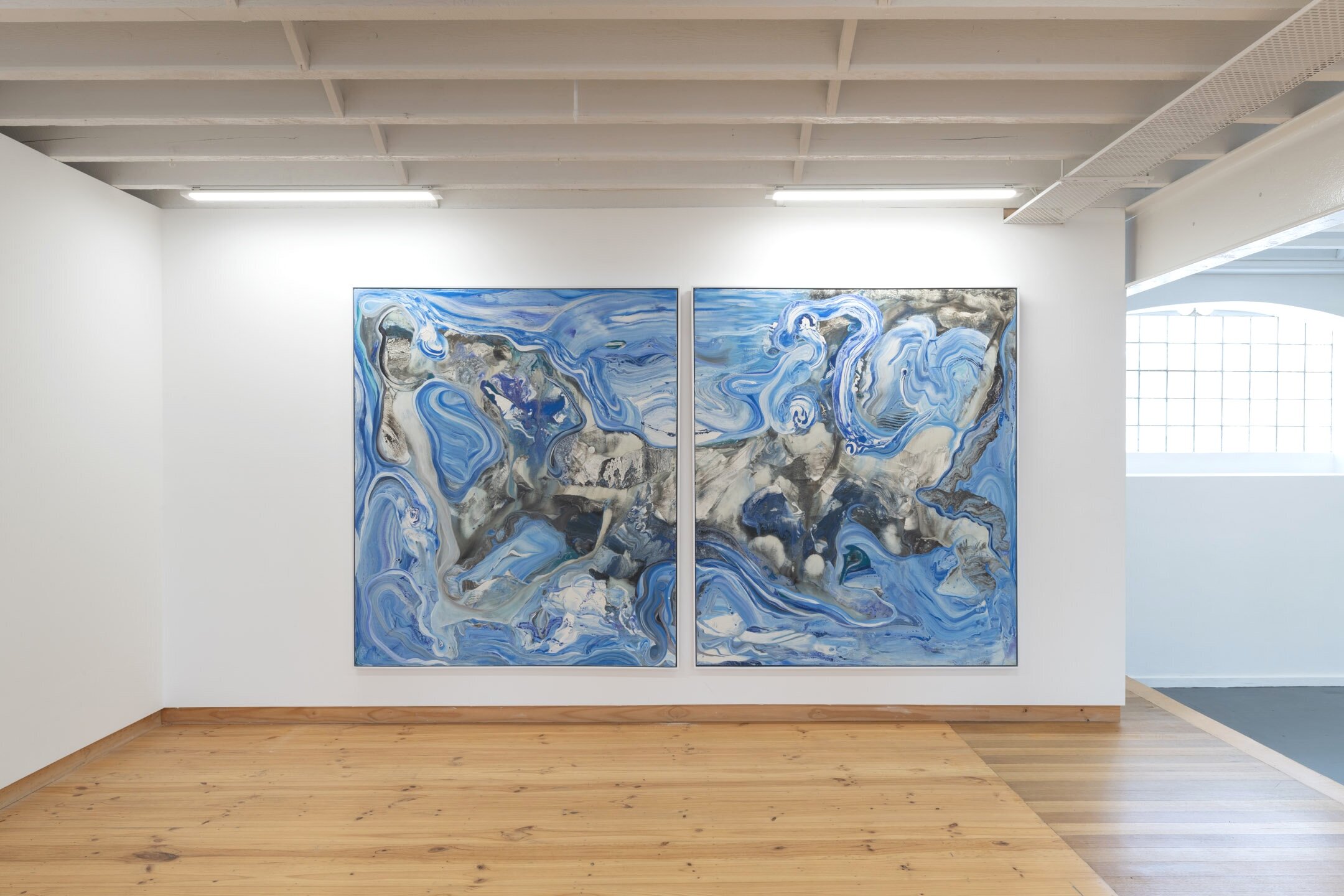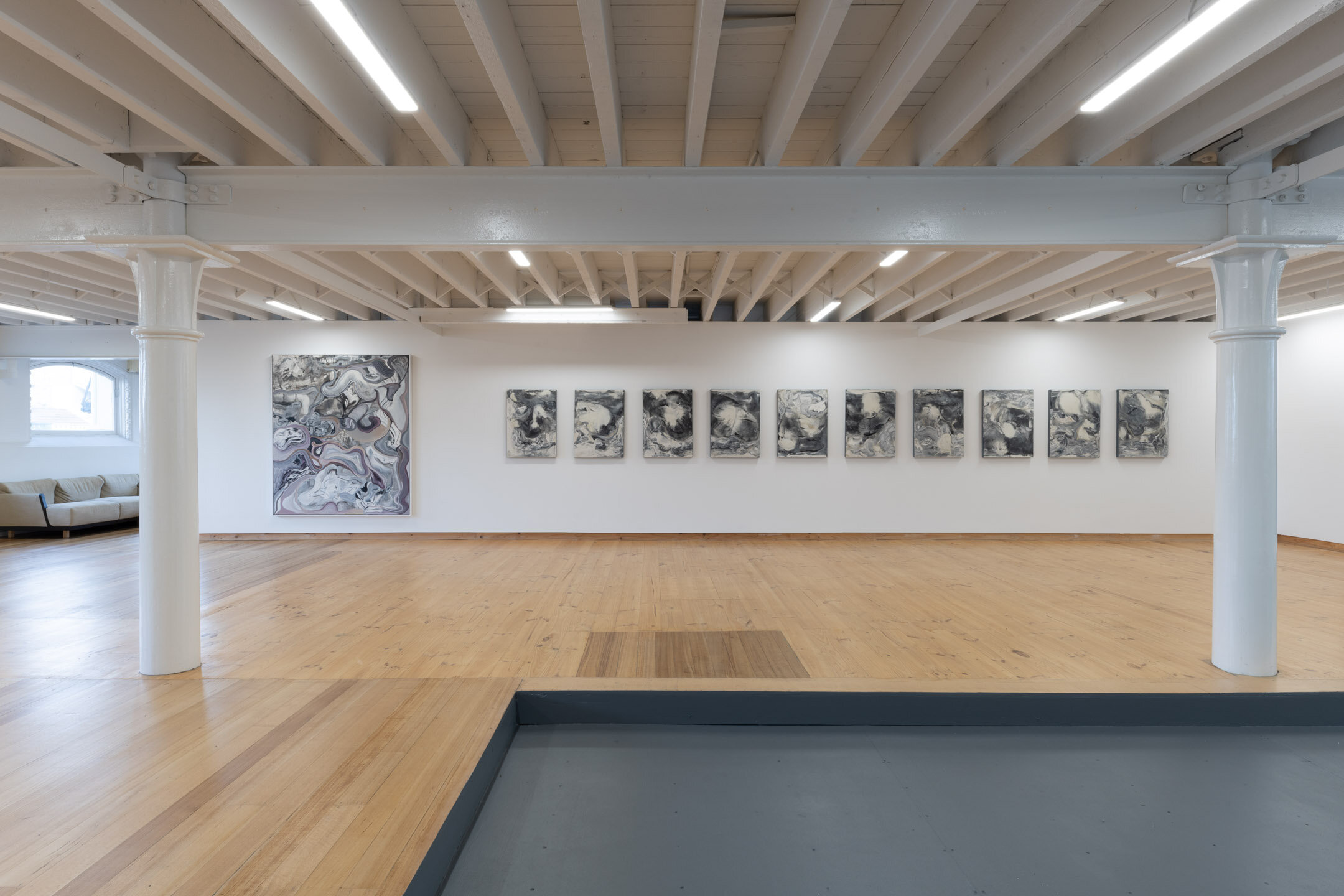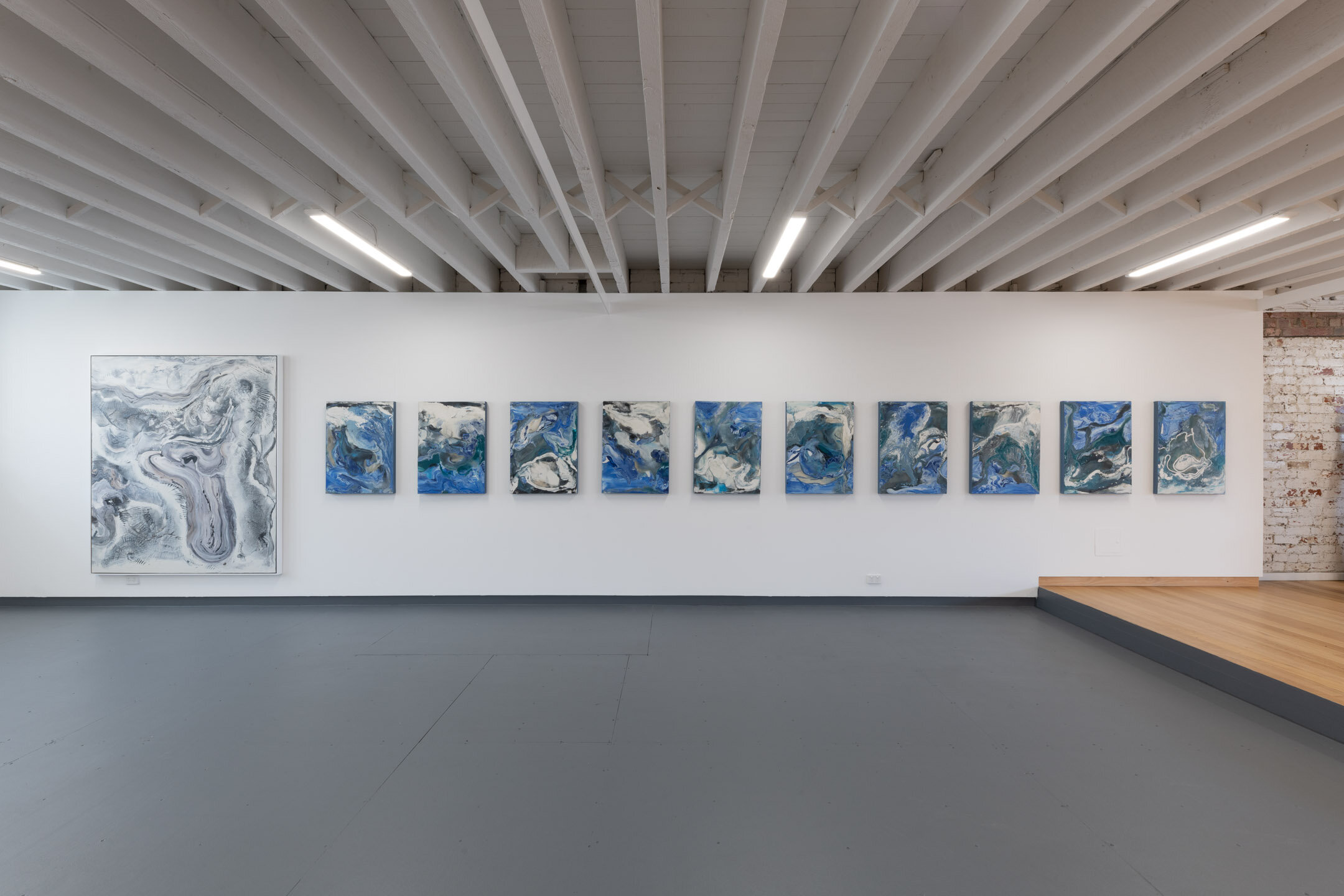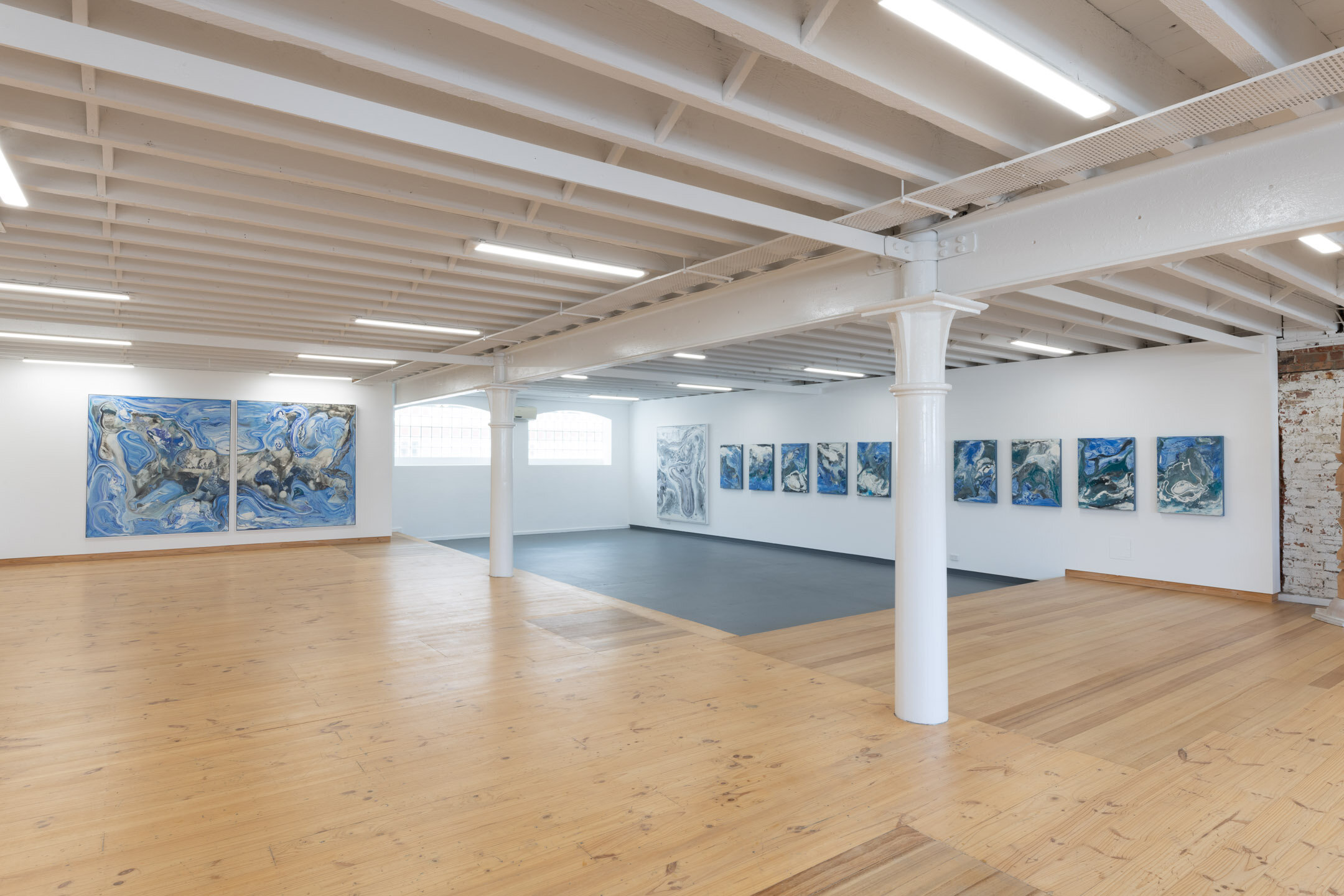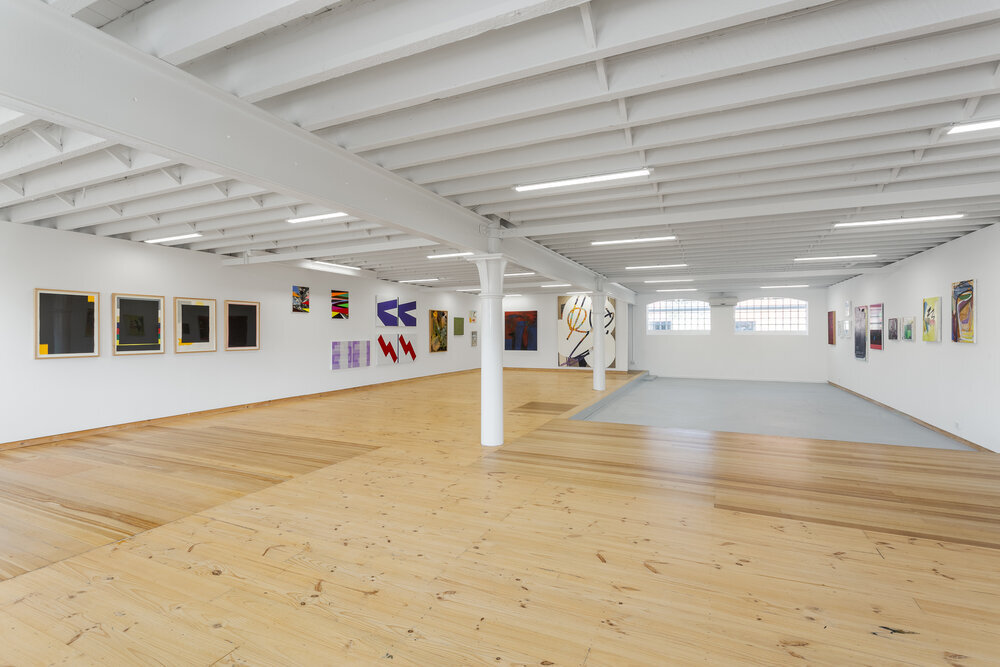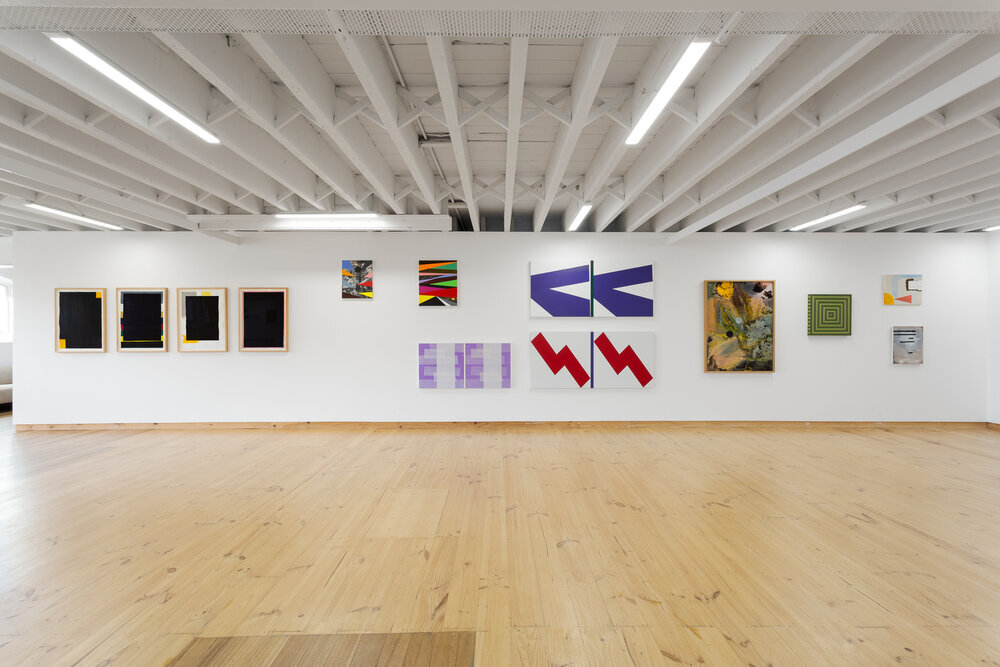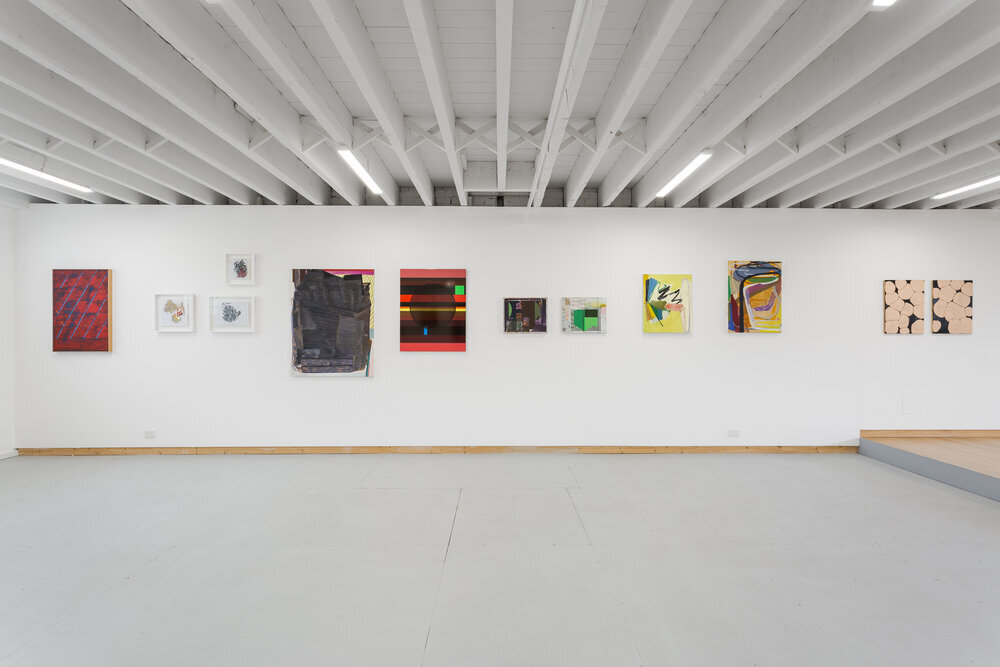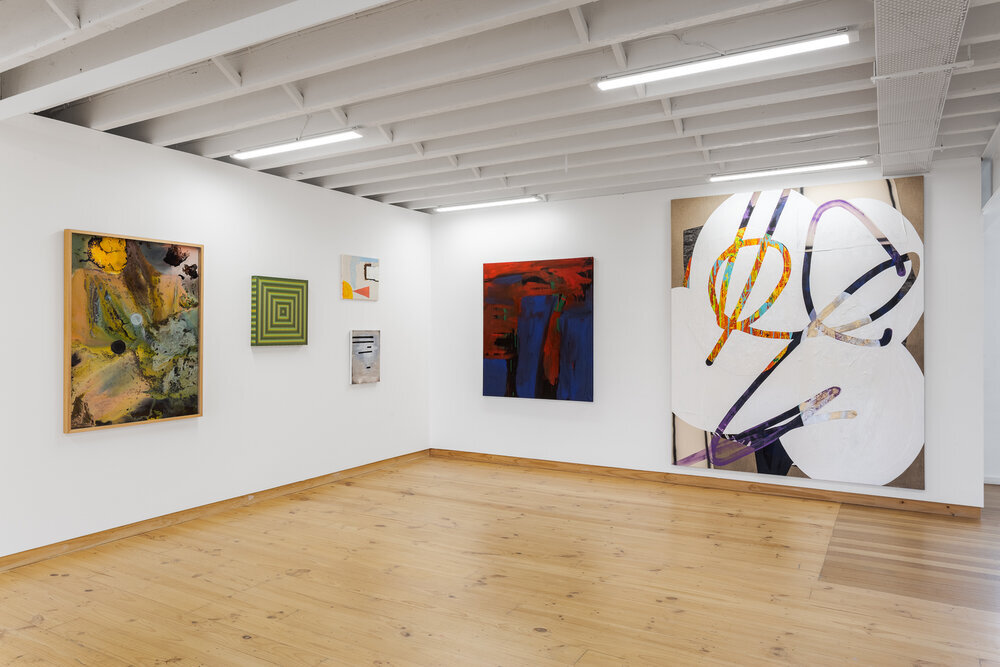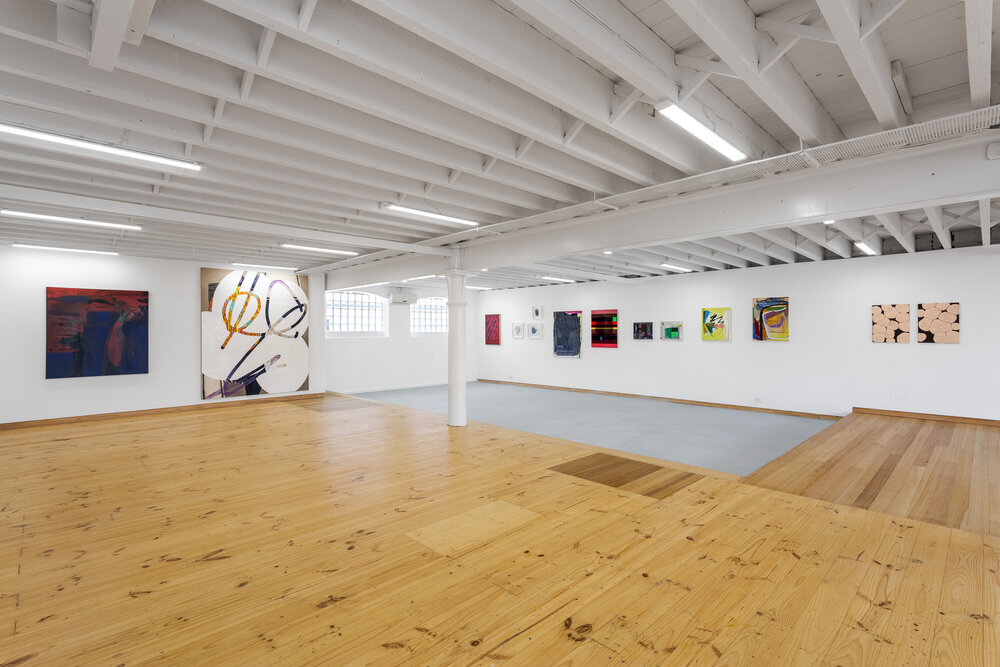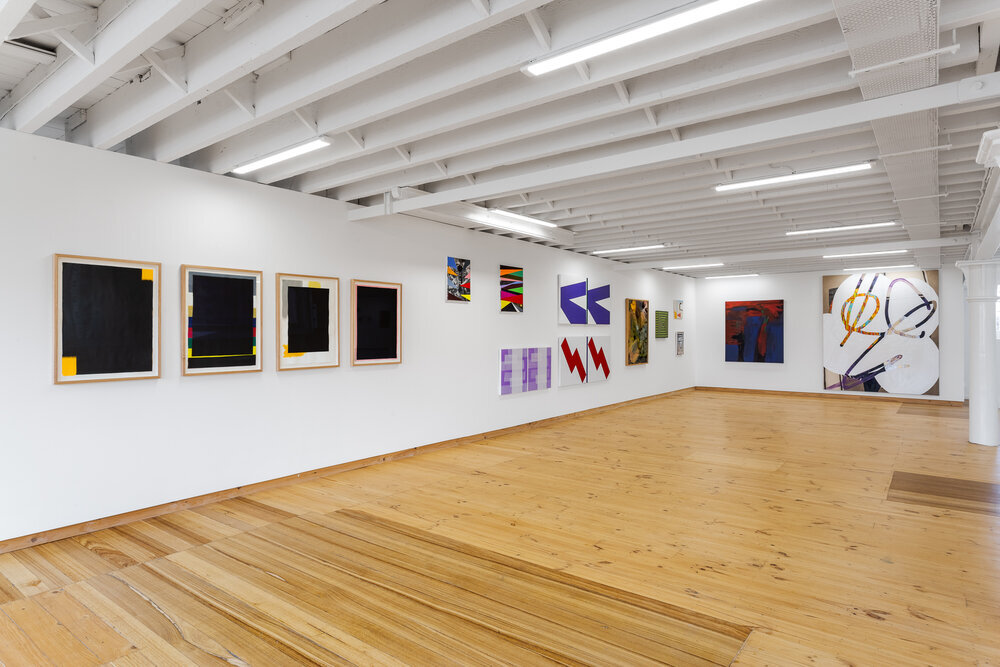eduardo santos: saudadeS
28.07.21 - 11.09.21
Installation images, Eduardo Santos; Saudades. Blockprojects, 2021. Photography: Simon Strong
“The Soul never thinks without a picture.” Aristotle
Santos is known for dense complex paintings that verge on sculpture. The arid cracks and patina generated by raw pigment and sand create surfaces that are haptic and mobile. His physical methods of buidling up the layers (or skins) of each picture is driven by the fluid movement of paint that seems to push at the chemical limits of movement and opacity. The gestation of each picture is gradual.Each piece takes time to accrete. Santos watches the paint as it bleeds. The work he leaves to dry each night often mutates by morning. Unguided by a controlling hand or contriving brush, the process feeds on itself.
The “Saudade” paintings explore proportion, both compressing and expanding in their scale. Like the lens that zooms from the astral to microscopic view, these works shift from the aerial to the subterranean. As a result, they can feel both weightless and encrusted. The collection of paintings is flamboyantly maximalist yet strangely self-contained. The monochrome works absorb light like a vacuum. They remind me of the terror of outer space. And though it seems literal to draw a comparison between pockets of negative space in the belly of a painting and the punctured holes of the ozone layer, the image is salient. Contemporary art with any real relationship to nature confront ruin.
Painted in the arduous and repressed cycle of isolation during the pandemic, these works stage a catharsis. Absorbed in an atmosphere of tension they answer the collective desire for release. In them l find a nostalgia for freedom. Physical, geographic and spiritual freedom. To express a very complex context Eduardo Santos looked to the concept of stasis and the conflicted desire it inspires. Memory stained by both elation and sorrow is roughly the English translation of the Portuguese word “Saudade”. The Fado song “Saudade” by Cesaria Evora speaks of an endless cycle of return, a state of longing hinged on distant. It is natural to mourn a place that is sealed off, partitioned by hard borders. The artist describes his recollections of Brazil like a strata, both compressed and visceral. Over years it has served as the atmospheric bedrock of intensely abstract paintings. Works that encircle and absorb the pattern of their own forms. Works that defy the weight of materiality, expanding beyond the sum of their parts.
Anna Johnson. 2021
BOOK YOUR APPOINTMENT to visit the gallery.
q&A: eduardo santos
Brazilian painter and photographer Eduardo Santos presents Saudades, his third and largest solo exhibition with Blockprojects. As the title suggests, it is imbued with a certain melancholy: a dreamscape expressive of Santos' longing for the topography and environs of his homeland.
The Portuguese word saudades can also imply a recollection of happier times, events that brought joy and pleasure, that we look back on with a certain pang. It is most closely translated in English as 'bittersweet', a feeling of wistfulness that many people can identify with under the present circumstances. Santos aims for a universal expression of feeling, to offer solidarity with the viewer, and provide artistic succour in these times of emotional pain, forced separation, and anxiety.
Can you tell us how long you have been working on these paintings, and the conception of the exhibition. Obviously the crisis situation we have all been enduring would have had an influence on your approach? The title seems to be both a bit nostalgic, and possibly an acknowledgement of loss at this time.
I have been working on this series since the beginning of the year. Our current situation [with the pandemic] definitely had a big impact on my approach, and I guess that's how my metaphor for these paintings was born.
I know a lot of artists decide on the title for the particular body of work after it's finished. For me, it all started with the realisation of where I found myself at this present moment in my life.
It was as though a single word could pinpoint my feelings, and trigger my senses. "Saudades" was the guide that I needed to help me hold onto the emotion and memory that was rising within me; it couldn't be more perfect. My narrative for this series of works has developed into something that I don't recall experiencing before.
As I executed the works, the unexpected was revealed; at the same time came a realisation that I have tapped into my own essence, my heritage. That perhaps the culture of the country in which I was born, and left when I was only eighteen years-old, was asserting itself after I have been abroad for twenty-nine years now.
The truth and meaning of "Saudades" is one that is difficult to translate into English. It is a feeling that is hard to explain. I hope that the viewer emerges from viewing my work with a better sense of what is important in their own life, and the connections that matter to them.
Your works have a timeless quality, and yet you must also respond to the world we live in, both as an artist, and as a fellow traveller on this precarious path of life. How do you resolve those tensions within your work, and do you find it easier depending on the medium you employ?
Artistic integrity is a factor from the moment I commence a work. I build my own frames and mount the canvas on board. My concept is that the work, literally, never has to leave its frame: that is its home, its foundation I have made for it. I’m a self-taught artist. I did study fashion and print design, but as I matured that passion dissipated, and I came to realise that I needed something more meaningful. I did not yet realise that I needed to express what was internal.
I never felt the need to study painting [formally]. From my earliest childhood days, I was an adventurous and curious child, and have never stopped creating since that time. Subconsciously, I think I knew that something that is so internal and personal [as creativity] cannot be taught by a teacher, right? It can only be discovered and expressed by the maker themselves.
Perhaps not going to art school has allowed me to experiment with a high diversity of material within my practice, and my curiosity about the unknown has resulted in an exploration of how materials interact. Possibly if I had not turned out to be a painter, I might have become a biologist! As you can see in my work, I have a thing for organic matter: oil, acrylic, and natural pigments are mostly what I use throughout.
From being a young man you have travelled widely, and absorbed influences from many cultures and traditions. You have lived in Australia since 2009, how has that influenced your work?
Different places where the sun shines high have always inspired me. I love travel and discovery, new cultures. The light of a place is very important for my wellbeing, and plays a big part in my work. I guess it's a doorway back to the place where I was born in the north of Brazil, and that is definitely why beautiful and bright Australia feels home to me now.
The creative consciousness is vast, and I believe everything is connected. Nature functions with one inextricable purpose: moving, going forward, and evolving. The energy of life, the cosmic energy that drives us all on, is present every single moment of our life. Always, with the same process of renewal: one strand of hair falls from your head to create space for a new one; a leaf falls from a tree somewhere else in a cycle that ushers in new growth. I think that is why sometimes a number of similarities can be found in the work of artists from very disparate backgrounds.
I don't plan, I never envisage what painting I'm going to create. I let things evolve, and the desire to discover the unseen is like a process of connectivity. When I feel this connectivity, it is like a sensation and a tingling running under my skin, emanating from the earth, the sand and rocks. It is a connection both to the sky and earthly matter that can't be completely represented.
One of the reasons I don't give a title to individual works is because I find it unnecessary, and it can impede the viewer's connection with my work. I love to see my audience free to see what they want, and find their own connection within their own experience. My work always connects somehow, or reminds people of something.
Your palette is quite limited in this body of work. Was that a deliberate choice to contrast the bright blue with the more subdued grey/black tones?
Initially, I thought this body of work was going to be monochromatic, more black-and-white, but as it evolved, and after I finished the first ten small black-and-white works, I felt that something was missing. As I dived deeper into my metaphor, there was no question that I needed to bring in the colours that most resonate with me about Brazil, blue and green. They had to come in for the work to feel complete.
You are descended from the Amazonian tribes of your native Brazil. You have previously spoken about the formative influence of your Grandfather, and his pottery making, on your art and the philosophy of your practice as an emerging artist. Does this remain a factor in your artistic maturation?
My maternal Grandfather 'escaped' his tribe as a child, or that is what he grew up believing. My family has a different theory: we think that he might have been kidnapped, or taken by a farmer. Back in those days, it was quite common for farmers to seize Indigenous Indians for forced work/slave labour on their farms.
It is a story that has been lost to us really, as he was never able to talk much about his childhood, apart from what he remembered about working on the land of this farmer. Later in his life my Grandfather became the owner of his own land. He did not have many possessions and built his first mud house by himself. He was incredible with his hands: he could make a basket out of coconut leaves in minutes.
I can't remember so clearly, but he used to take me to collect clay from the riverbanks for making cooking pots and water jars, caps and bowls. Many times my Mother would collect me from my Grandfather to take me home and I would be covered in mud. I can still taste the flavour of the mud, sometimes I can feel it on my skin and under my nails, the same sensation that I have when I paint.
My Mother was working full-time as a teacher, and had four children, so I spent most of my early years bouncing between the care of her parents and them looking after me. I don't know if I would have become the artist that I am today if I had not had that formative experience with them.
My initial love for fashion came from sitting and watching my Grandmother sewing. While I sat on the floor she would tell wonderful stories as I played with the fabric off-cuts that would fall on me. She was a dressmaker, also self-taught. Neither of them had any kind of school education, but the schooling they gave me was the best Art School that I could ever wish for. It had a magical and profound impact on me. Both my Grandparents were functionally illiterate, yet they instilled in me the belief that we are all capable of great things. I honour them in my artwork.
ARTWORKS:
enquire.
HOW SOON IS NOW
12.08.20 - 12.09.20
Installation images, How Soon is Now. Blockprojects, 2020.
Blockprojects is proud to present, HOW SOON IS NOW,
an exhibition featuring fifteen contemporary artists who explore the mystery of abstraction.
ARTISTS:
Darren Munce
Julia Powles
Eduardo Santos
David Thomas
Tom Vincent
David Wallage
Peter Westwood
Neil Keith Baker
Merric Brettle
James Clayden
Dandan Dai
Robert Doble
Marc Freeman
Kyle Jenkins
Jason Haufe
